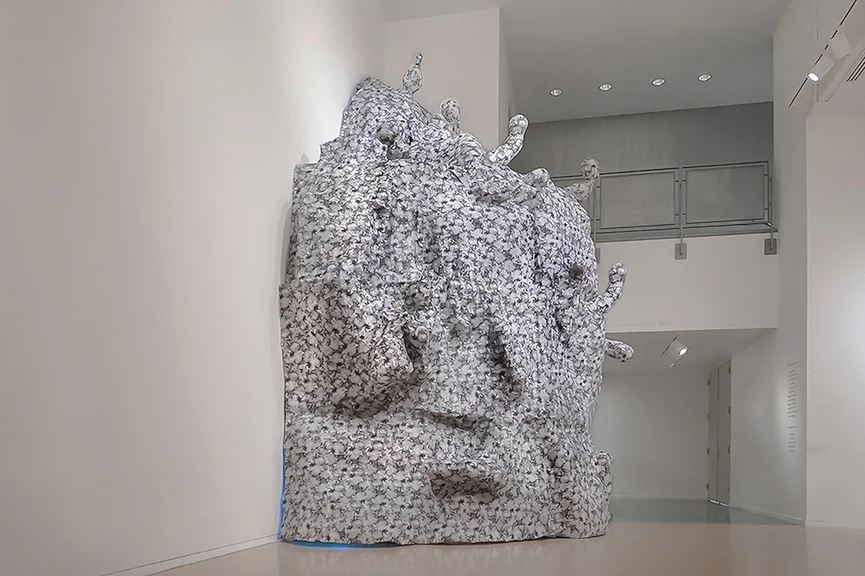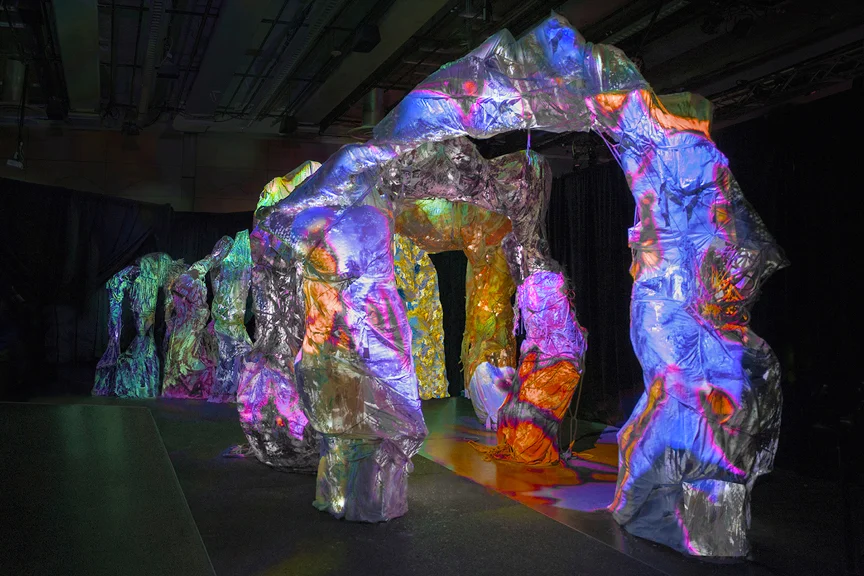Dakota Gearhart
Dakota Gearhart is the progeny of a philosophizing mechanic and a feminist director. Identifying as a bisexual mermaid, her strategies in photography, video, and installation respond to and expand on emergent qualities in nature and culture through staged fantasy. Dakota has exhibited at the Henry Art Gallery, Seattle; On The Ground Floor, Los Angeles, BronxArtSpace, New York, FalseFront, Portland; Vulpes Vulpes, London; and Taiyuan Normal University Gallery, Shanxi. She is the recipient of the Artist Trust Project Grant, the 4Culture Individual Project Grant, and the Jane Davis Fellowship. She received her BFA from Florida State University and her MFA from the University of Washington. Currently, she lives and works out of a decomposing cement box in the Pacific Northwest.
Statement
I work between mediums to create immersive environments using contemporary modes of collage and post-production. Switching between analog and digital modes of cutting, I toy with infinitely scalable worlds to explore the fragile terrain between desire and excess. Here ecology, intimacy, and digitization are crossed with feminist narratives on consumption, in an effort to illuminate the fears latent in notions of futurity. To this end, I embrace the apocalypse--both personal and political--and I reject received notions of the sacred. My videos, photographs, and installations are composed of "waste" gleaned from sites such as compost bins, microbiology labs, spam folders, and junk yards. This cultural detritus is then redirected in a color-sensitive and theatrical manner to create what I like to think of as synthetic paradises, which the viewer completes through physical and/or conceptual immersion. My intention is to reimagine the ways in which we perceive, select, and move through our many possible futures.
Q&A with Dakota Gearhart
by Sidney Mullis
Hi Dakota! What initially interested you in speculating futures?
As a creative person, I think that concern is my job. To imagine and to help people imagine possibilities other than what is present. To give form to what doesn’t exist is to understand there are options outside of what does.
How do you prepare for your exhibitions? Do you build maquettes?
I research. I visit the site. I talk to people involved; from the curator to the cleaning person, who is sometimes the same person (yay DIYspaces, you are keeping art alive!). I build small models and make sketches in photoshop. The impossibility of translating those digital sketches to the plane of what is physical really fascinates me. Taking what’s best about digital media and making it habitable. Learning from artists like Niki de Saint Phalle, Ann Hamilton, and Pipilotti Rist who’ve always amazed me their ability to understand the risks, nuances, and rewards of scale.
What is the installation process for an exhibition like for you?
It’s kind of art gymnastics and different each time. The installs are logistical reality as it intersects with dreaming. However, it's all scheduled and organized efficiently. And most importantly, I’ve worked with people who are supportive and understand experimental motivations. To thank a few: Julia Greenway of Interstitial, Kira Burge of Seattle Art Fair, Jason Doizé of Falsefront, artist Brandon Aleson, and photographer Joe Freeman.
You have an extensive breadth of materials that you employ in your pieces, including yams, donated bed sheets, vanilla extract, dresser draws, and much more. How do you come to choose and amalgamate your materials for particular pieces?
I go on walks and see what is unwanted. I decide to want it. Then I let it sit in my mind and hear it’s cause.
I totally enjoy how you describe the Pathway of Stranger Living as a taxidermy rainbow. How did you come to attain so many donated bed sheets to make this 40-foot deep installation?
For a while I was a personal assistant for a Seattle entrepreneur who, among other things, started an industrial laundry service. The business washed sheets for hospitals and then usually just threw them away. So I got to thinking about it and asked him if I could have them. He brought me hundreds and hundreds of sheets.
You recently completed your MFA at University of Washington in 2013 and have had an amazing trajectory afterwards, including numerous exhibitions, residencies, and awards. How was your transition out of grad school? Any words of wisdom for the recently graduated?
Don’t self-isolate. Try to reach out and spend time with other artists. Artists need each other and nobody makes it alone. I used to think that being alone was really romantic and deep, and it is, but there’s also really something deep about connecting with a group of people who are going through the same struggles and sharing the same desire to be a good artist. The more we get to know people that are creative, the more supportive we become of each other. Some people look down on it and see it as networking and capitalism at work, and in some ways it is, but it’s much more meaningful than that. It’s connecting with your people in the world who are on the same wavelength. For me, this is much more valuable than money or fame.
What is the most important thing to you about your studio practice?
When I’m depressed and sad about life that I’m able to have my art. And through it, I meet minds that were never advertised to me as kid, you know, like sincerely strange people who are curious about this odd predicament of being alive and conscious.
What artists are you currently interested in? What other topics or genres (perhaps outside of the visual arts) influence you? Do you read/write a lot of science fiction?
My favorite artist right now is Molly Lowe. I’m also into Meg Hartwig, Jesse Moretti, and Kello Goeller. The science fiction writer Ursula K Le Guin is a big influence, as well as philosopher Phillip Thurtle. I’m working on a book of stories, but otherwise my writing comes out in my videos.
Anything else you would like to mention or share with us? Any projects or upcoming shows in the works?Thanks for asking. I’m in the Northwest Art Now exhibit at Tacoma Art Museum until September. Then an installation coming up in Seattle with the Recology program. A few big ones in 2017. Check @tiffkota on Instagram or www.dakotagearhart.com to get in touch. All my love. Thank you!
Thanks so much for sharing your work and talking with us!
To find out more about Dakota and her work, check out her website.











